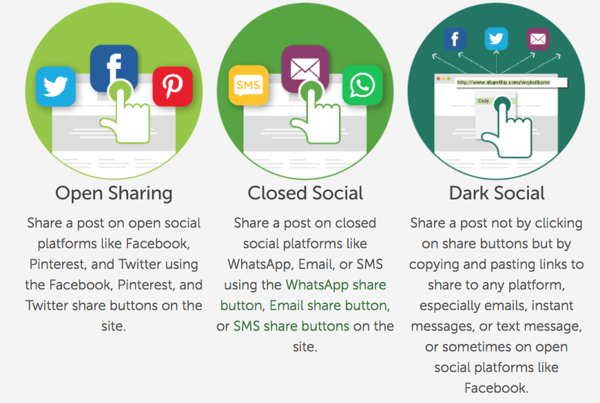Are you seeing an uncomfortably large amount of “direct traffic” you can’t quite explain? Dark social - direct sharing of content through private messaging apps - might be the reason for your mystery traffic. And that’s a pretty great thing.
The term ‘dark social’ was coined in an article written in 2012 by former deputy editor of The Atlantic, Alexis Madrigal. Dark social is when people share content through private channels such as instant messaging programs, messaging apps, and email," explains HubSpot.
The world of content sharing
There are three main ways people share content:
- Open sharing: sharing through the “share” buttons provided by most sites, to open tracking platforms like Facebook.
- Closed sharing: using that same “share” button to send content to untrackable platforms like WhatsApp (but at least we can see that they shared it there initially, even if we can’t track its movement within WhatsApp).
- Dark sharing: Untrackable. An individual copies a link, and shares it through email, WhatsApp, Facebook messenger, and so on. What you’ll see on the traffic side is a lot of direct traffic to certain posts that you can’t quite understand.
 Image from Contently
Image from Contently
Though the mystery traffic might drive a marketer mad, there’s actually a pretty huge pro to Dark Social sharing: Those referrals are more likely to convert!
Think about it: if someone messages you a link to an article, it’s because that article in particular relates to you and your pain points. This means that the article is answering those questions - and if a content offer or drive to consult with the experts is the Call-to-Action (CTA), you’re far more likely to take that leap based on the content’s origin (a trusted resource).
Why do people use dark social?
- Embarrassment - it might be a link they feel uncomfortable putting on their more open platforms
- No social at work - some companies don’t allow social media at work, which means the only way to share that hilarious listicle is to copy the URL and discretely message it to a friend.
- More intimate - perhaps you want to show that friend or family member that this link is for them, and that you’re thinking of them specifically. A link might be shared with that personalisation in mind.
- The personal vs the persona - “The data suggests there’s a discrepancy between the persona we present to the world on open social versus our deeper desires and interests reserved for private sharing. Over dark social, the most popular content categories included business education, counselling services, self-help, religion, and medical conditions. In fact, content with intimate words such as “God,” “Lord,” and “love” were often shared via dark social,” says Contently.
In other words, Dark Social has become today’s equivalent of word of mouth, and it shows people’s true interests - because, for example, though you might be willing to recommend the period tracker app to a friend in a private message, you might feel uncomfortable blasting that same message across her social media platforms. The other good news? Dark social sharing indicates that you’ve got some darn good content. “Your dark social insights will help you understand the qualities of high-performing content, plus the topics and titles that get more shares,” says Vendasta.
- Messaging apps: like WhatsApp, Facebook Messenger and Instagram direct.
- Email: In its nature secured, links sent via email are untrackable.
- Native social apps: Like Facebook and Instagram
- Secure browsing: This is designed to mask traffic sources
- Bookmarked links: Saved and bookmarked, this can be revisited at any time
- Actually retyping a link: Yup - some people still do this! From, for example, a print advert.
And now to the trickier part - how do you actually find this in your data?
How to find dark social in your analytics
- Look for long, direct links in your direct traffic
- "You could set up a segment in your analytics that takes into account all direct traffic links with parameters, so for us it would be links that aren’t eConsultancy. com, eConsultancy. com/blog and so on,” says eConsultancy.
- Start adding a CTA to blogs with direct links and make sure your forms ask the question, "How did you find this post?".
- It’s also possible to configure your Google Analytics, and the Social Media Examiner explains how here.
The next trick, of course, is to encourage the behaviour you want in your audience.
Here’s how to get trackable shares:
- Make your social sharing buttons more obvious! Using tools like Shareaholic will help this
- Include platforms like WhatsApp and email in your share buttons (you at least see if they’re going there!)
- Use shortened, trackable links where ever possible. For example, if your sales team uses your content to sell, make sure they have their own shortened links so you can track actions taken on a piece of content, even in an email.

As Contently says, “Dark social is too big to ignore.” We hope you start investigating your direct traffic to really understand what’s driving your buyer personas.
Make sure you're exploring every touchpoint your audience might be sharing your content. Download our Inbound Touchpoint guide:
